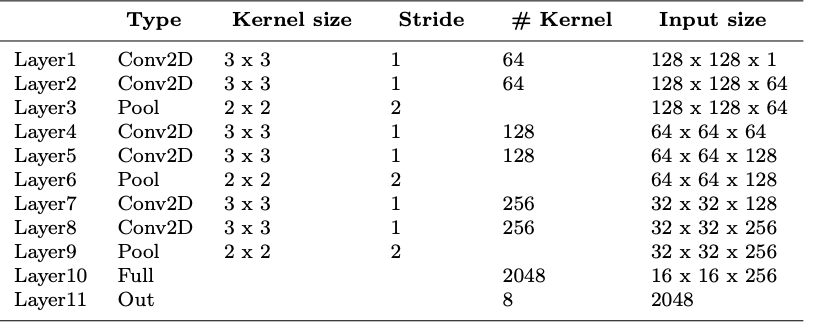So I’m new to Deep Learning and I’m trying to create the following CNN architecture on PyTorch:
This is what I have for code so far:
import torch.nn as nn
from torch.autograd import Variable
import torch.nn.functional as F
class CNet(nn.Module):
def __init__(self, num):
# Input x is (128, 128, 1
super(HeartNet, self).__init__()
self.features = nn.Sequential(
nn.Conv2d(3, 64, kernel_size=3, stride=1),
nn.ELU(inplace=True),
nn.BatchNorm2d(64, eps=0.001),
nn.Conv2d(3, 64, kernel_size=3, stride=1),
nn.ELU(inplace=True),
nn.BatchNorm2d(64, eps=0.001),
nn.MaxPool2d(kernel_size=2, stride=2),
nn.Conv2d(3, 128, kernel_size=3, stride=1),
nn.ELU(inplace=True),
nn.BatchNorm2d(128, eps=0.001),
nn.Conv2d(3, 128, kernel_size=3, stride=1),
nn.ELU(inplace=True),
nn.BatchNorm2d(128, eps=0.001),
nn.MaxPool2d(kernel_size=2, stride=2),
nn.Conv2d(3, 256, kernel_size=3, stride=1),
nn.ELU(inplace=True),
nn.BatchNorm2d(256, eps=0.001),
nn.Conv2d(3, 256, kernel_size=3, stride=1),
nn.ELU(inplace=True),
nn.BatchNorm2d(256, eps=0.001),
nn.MaxPool2d(kernel_size=2, stride=2)
)
self.classifier = nn.Sequential(
nn.Dropout(0.5),
nn.Linear(16*16*256, 2048),
nn.ELU(inplace=True),
nn.BatchNorm2d(2048, eps=0.001)
nn.Linear(2048, 8)
)
def forward(self, x):
x = self.features(x)
x = x.view(x.size(0), 16 * 16 * 256)
x = self.classifier(x)
return x
Am I on the right track here? I also found a keras equivalent for the architecture and I was confused on how to translate the last portion of the fully connected layer into PyTorch, this is how it looks like in Keras below:
model.add(MaxPool2D(pool_size=(2, 2), strides= (2,2)))
model.add(Flatten())
model.add(Dense(2048))
model.add(keras.layers.ELU())
model.add(BatchNormalization())
model.add(Dropout(0.5))
model.add(Dense(7, activation='softmax'))
model.compile(loss='categorical_crossentropy', optimizer='adam', metrics=['accuracy'])
Any help or hints in the right direction is helpful, thank you!
